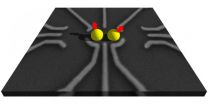(Press-News.org) DURHAM, N.C. -- Teenagers are irrational and make bad decisions. Or do they? A new Duke study finds that adolescents ages 10 to 16 can be more analytical in their economic choices than many slightly older young adults.
Published online in the October-December issue of Cognitive Development, the study suggests not only that society should give adolescents more credit for rationality but also that parents should help children hone their cost-benefit analysis skills in making real-life decisions.
"The new results point to the idea that we should not think of adolescents as being irrational," said corresponding author Scott Huettel, a professor of psychology and neuroscience at Duke. "What's different about them is they don't use simple rules as effectively."
Such simple rules are the mental shortcuts people take in decision-making -- often to their benefit -- as they age and gain more experience. Most adults apply the "don't drink and drive" rule, for example, to avoid getting in a car with someone who's been drinking. In contrast, teens may more carefully weigh this decision.
"Adolescents are going to be more likely to use cost-benefit analysis than the (simple rules) that adults use. That can get these kids into a lot of trouble," Huettel said.
In the new study, participants were presented with three scenarios (A, B, and C) and asked to pick the best one. Each scenario contained a set of outcomes that could lead to winning or losing different sums of money.
For example if the subjects picked scenario A, they had a one-third chance of winning, say $6, one-third chance of winning $4, and a one-third chance of losing $4. Scenarios B and C each came with their own chances to win or lose three different dollar amounts.
Young adults -- who were 22 years old, on average -- used simple rules. As they completed more trials, they counted the number of wins and losses in each scenario and picked the one with the most wins, ignoring the dollar amount of each potential gain or loss.
Adolescents, on the other hand, accounted for the magnitude of the potential win or loss and chose scenarios to minimize loss.
"I was surprised by how consistent the effects were," Huettel said. "Pretty much everywhere we looked, adolescents were the ones who looked more economically rational."
Tracking the participants' eyes as they completed the task gave clues about how they were processing the information. Adolescents consistently viewed almost all the possible outcomes of their choices throughout the experiment.
In contrast, young adults looked at almost everything initially, but as the experiment progressed they started to ignore information that wasn't useful to them. They also spent less time than adolescents viewing each outcome, the study found.
Other research has shown that adolescents aren't necessarily more risk-seeking but that they are more sensitive to good outcomes compared with adults. Teens also place more value in social interactions and approval.
Huettel's group is studying the role of peers in adolescent decision-making, while tracking eye movements and brain activity. This research, and the new study, may inform new ways of coaching adolescents to make smarter decisions, Huettel said.
INFORMATION:
The research was supported by the National Institute on Drug Abuse (P30 DA023026) and the National Center for Responsible Gaming.
CITATION: "The Rational Adolescent: Strategic Information Processing During Decision Making Revealed by Eye Tracking," Youngbin Kwak, John W. Payne, Andrew L. Cohen and Scott A. Huettel. Cognitive Development, Oct-Dec. 2015. DOI: 10.1016/j.cogdev.2015.08.001
http://www.sciencedirect.com/science/article/pii/S0885201415300022
ROCHESTER, Minn. -- Low-risk cancers that do not have any symptoms and presumably will not cause problems in the future are responsible for the rapid increase in the number of new cases of thyroid cancer diagnosed over the past decade, according to a Mayo Clinic study published in the journal Thyroid. According to the study authors, nearly one-third of these recent cases were diagnosed when clinicians used high-tech imaging even when no symptoms of thyroid disease were present.
"We are spotting more cancers, but they are cancers that are not likely to cause harm," says ...
This news release is available in French. Chemical substances that are safe for humans when taken in isolation can become harmful when they are combined. Three research teams bringing together researchers from Inserm and CNRS in Montpellier have elucidated in vitro a molecular mechanism that could contribute to the phenomenon known as the "cocktail effect." This study is published in the journal Nature Communications.
Every day we are exposed to many exogenous compounds such as environmental pollutants, drugs or substances in our diet. Some of these molecules, known ...
Got rope? Then try this experiment: Cross both ends, left over right, then bring the left end under and out, as if tying a pair of shoelaces. If you repeat this sequence, you get what's called a "granny" knot. If, instead, you cross both ends again, this time right over left, you've created a sturdier "reef" knot.
The configuration, or "topology," of a knot determines its stiffness. For example, a granny knot is much easier to undo, as its configuration of twists creates weaker forces within the knot, compared with a reef knot. For centuries, sailors have observed such ...
WORCESTER, MA -- Researchers at the University of Massachusetts Medical School are the first to show that it's possible to reverse the behavior of an animal by flipping a switch in neuronal communication. The research, published in PLOS Biology, provides a new approach for studying the neural circuits that govern behavior and has important implications for how scientists think about neural connectomes.
New technologies have fueled the quest to map all the neural connections in the brain to understand how these networks processes information and control behavior. The human ...
SALT LAKE CITY, Sept. 7, 2015 - If you are in a special relationship with another person, thank grandma - not just yours, but all grandmothers since humans evolved.
University of Utah anthropologist Kristen Hawkes is known for the "grandmother hypothesis," which credits prehistoric grandmothering for our long human lifespan. Now, Hawkes has used computer simulations to link grandmothering and longevity to a surplus of older fertile men and, in turn, to the male tendency to guard a female mate from the competition and form a "pair bond" with her instead of mating with ...
Physicists from the Department of Nanophotonics and Metamaterials at ITMO University have experimentally demonstrated the feasibility of designing an optical analog of a transistor based on a single silicon nanoparticle. Because transistors are some of the most fundamental components of computing circuits, the results of the study have crucial importance for the development of optical computers, where transistors must be very small and ultrafast at the same time. The study was published in the scientific journal Nano Letters.
The performance of modern computers, which ...
Developing transparent or semitransparent solar cells with high efficiency and low cost to replace the existing opaque and expensive silicon-based solar panels has become increasingly important due to the increasing demands of the building integrated photovoltaics (BIPVs) systems. The Department of Applied Physics of The Hong Kong Polytechnic University (PolyU) has successfully developed efficient and low-cost semitransparent perovskite solar cells with graphene electrodes. The power conversion efficiencies (PCEs) of this novel invention are around 12% when they are illuminated ...
Calculation with electron spins in a quantum computer assumes that the spin states last for a sufficient period of time. Physicists at the University of Basel and the Swiss Nanoscience Institute have now demonstrated that electron exchange in quantum dots fundamentally limits the stability of this information. Control of this exchange process paves the way for further progress in the coherence of the fragile quantum states. The report from the Basel-based researchers appears in the scientific journal Physical Review Letters.
The basic idea of a quantum computer is to ...
DENVER, Colo. -- The International Association for the Study of Lung Cancer (IASLC) today issued a new statement on Tobacco Control and Smoking Cessation at the 16th World Conference on Lung Cancer (WCLC) in Denver. The statement calls for higher taxes on tobacco products, comprehensive advertising and promotion bans of all tobacco products and product regulation including pack warnings.
"Tax policies that increased the cost of cigarettes have played a prominent role in the reduction of cigarette smoking," said Dr. Kenneth Michael Cummings, Professor, Hollings Cancer ...
Scientists studying funnel-web spiders at Booderee National Park near Jervis Bay on the New South Wales south coast have found a large example of an unexpected funnel-web species.
The scientists believe the 50-millimetre spider is a species of the tree-dwelling genus Hadronyche, not the ground-dwelling genus Atrax, which includes the Sydney funnel-web, the only species reported in the Park's records.
"It's remarkable that we have found this other species in Booderee National Park," said Dr Thomas Wallenius, from The Australian National University (ANU).
"It shows ...



